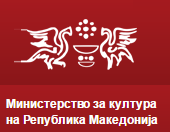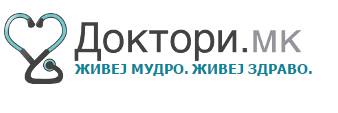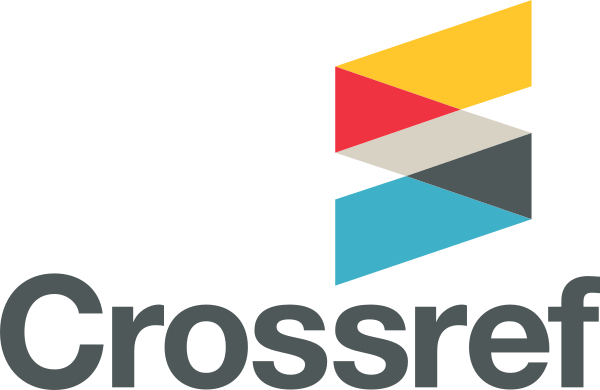JSER Policies
JSER Online
JSER Data
Frequency: quarterly
ISSN: 1409-6099 (Print)
ISSN: 1857-663X (Online)
Authors Info
- Read: 106273
|
РАСТРОЈСТВА ВО ОДНЕСУВАЊЕТО
1Филозофски факултет, |
|
BEHAVIORAL DISORDERS IN ADOLESCENTS WITH MILD INTELLECTUAL DISABILITY
Zoran KITKANJ1
1Faculty of Philosophy, “Idnina” – Skopje |
|
Примено: 28.06.2013 |
|
Recived: 28.06.2013 |
|
|
|
|
|
Вовед |
|
Introduction |
|
|
|
|
|
Нарушувањата во однесувањето се проблем во општеството на кој треба да му посветиме поголемо внимание. И кај лицата со интелектуална попреченост често се среќаваат разни форми на девијантно однесување. |
|
Behavioral disorders are a problem in society that needs to be paid more attention to. Various forms of deviant behavior are also often encountered in people with intellectual disabilities. The risk factors affect the increased likelihood of emergence of deviant forms of behavior, while the protective factors reduce this impact by changing the way the young person reacts in a particular situation. The risk factors and protective factors exist in all social contexts in which social interaction takes place. These social contexts are called domains, and they include family, school, peers and social environment (1).
The family represents the primary group in which, beginning from the birth, the foundations of the future individual are being shaped and the process of education and socialization takes place. Within the family, the child builds its moral character, the intellectual predispositions, as well as the first characteristics of its personality are being developed and a picture is being created about its own values and the values of other people (2). The dysfunctional families are generally poor, single parent families and families with a large number of children. These are usually socially isolated, and the parents have insufficiently developed communication skills and empathy and lower opinion of their own skills (3). The school also represents a very important factor in the development of a person and its socialization in general. If an adolescent has been positively accepted in school, it develops a feeling of security and it has a greater level of academic achievements; on the contrary the school becomes a source that generates inconveniences. The failure in school increases the risk of leaving school, using illegal substances, development of delinquency and other forms of deviant behavior (4). Socializing with peers is very important for the development of a personality, especially in the period of adolescence. They may generate powerful protective and risk factors. Young people are usually looking for peers that are similar to them and they expect emotional support, if they don’t get the same in the family environment (5). The supporting friendships are of importance for the proper development of the adolescent’s personality. In such cases they show a greater level of self-respect, higher reputation amount their peers and increased level of academic achievements (6). There are groups in which the individuals are particularly linked with each other, but they have an aggressive and delinquent impact, so the risk factors that appear within such groups are considered to be the most important ones in the period of adolescence. The negative influences of peers that develop in the period of adolescence have the tendency to transform into more serious forms of antisocial or delinquent behavior (7). |
|
|
|
|
|
Причини и видови растројства |
|
Types of behavioral disorders |
|
|
|
|
|
Лицата со лесна попреченост во интелектуалниот развој, поради нивната лесна поводливост и сугестибилност, спаѓаат во групата на ризични лица кај кои можат да се појават разни неприфатливи форми во однесувањето. |
|
Because of being easily persuaded and due to their suggestibility, the individuals with mild disability in their intellectual development belong to the group of vulnerable people where various unacceptable forms of behavior can occur.
|
|
|
|
|
|
Материјали и методи |
|
Materials and methods |
|
|
|
|
|
Основна цел на истражувањето е да се утврди ризикот од појава на растројства во општественото однесување кај адолесцентите со лесна интелектуална попреченост кои живеат во семејство во споредба со нивните врсници сместени во ученички домови.
Истражувањето беше реализирано во ДСУ „Искра“ од Штип и ДСУ „Св. Наум Охридски“ од Скопје во периодот од април до мај 2011 година. Во текот на истражувањето беа опфатени испитаници од обата пола. |
|
The main objective of the research is to determine the risk of emergence of disorders in social behavior in adolescents with mild intellectual disabilities living in families, compared to their peers housed in student homes. The research included:
The research was performed in state secondary school (SSS) “Iskra” in Stip and SSS “St. Naum Ohridski” in Skopje in the period from April to May 2011. The research included respondents from both genders. |
|
Методи на истражување: дескриптивен метод и метод на компаративна анализа. |
|
Methods of research: descriptive method and method of comparative analysis |
|
Техники и постапки во истражувањето: анализа на постоечката документација, анкетирање и полуструктуирано интервју. |
|
Research techniques and procedures: |
|
Во истражувањето беа користени следниве инструменти: анкетни прашалници наменети за воспитно-образовниот кадар и членовите на стручниот тим. Анкетниот прашалник се состои од прашања кои се од затворен и отворен тип, специјално подготвени за потребите на истражувањето, на кои испитаниците одговараа со селекција на еден или повеќе од понудените одговори, како и со дополнување на сопствени видувања за проблемот. |
|
The following instruments were used within the research: questionnaires for the educational staff and the members of the expert team. The questionnaire includes closed and opened questions, specially prepared for the purpose of the research and the respondents were answering the questions by selecting one or more of the offered answers, as well as by adding their own opinion in respect of certain problems. For one part of the educational staff a protocol (guideline) was used for the interview in order to explain the questions in detail for the purpose of obtaining more relevant answers. Interview protocol (guideline). The obtained answers are presented in tables and graphical display. The testing of the hypothesis was carried out using the Windows program R x C for analysis of contingency tables and the Fisher Exact Test. The differences at the significance level of p <0.05. |
|
Резултати |
|
Results |
|
Табела 1:Видови растројства во однесувањето според воспитно-образовниот кадар |
|
Table 1: Types of disorders according to the educational staff |

Fisher Exact test p= 0.156 p>0.05
|
Од табелата се забележува дека во двете училишта како најчесто манифестиран облик на растројство во однесувањето кај учениците се посочува деликвенцијата 62,3%. Спред зачестеноста следува проституцијата со 16,4%, алкохолизмот со 11,5%, а во значително помал процент (под 5%) се среќаваат обидите за самоубиство, наркоманијата и хазардните игри. |
|
The table indicates that in both schools the most common manifested form of deviant behavior among students is delinquency with 62.3%, followed by prostitution with 16.4%, alcoholism with 11.5%, while suicide attempts, drug abuse and gambling are represented by significantly lower percentage (under 5%). |
|
|
|
|
|
Табела 2: Информираност на учениците за последиците од разните видови растројства според воспитно-образовниот кадар |
|
Table 2: Awareness of students about the consequences of various types of deviant behavior according to the educational staff |

Fisher Exact test p=0.003 p<0.05
|
Табела 3:Самоиницијативно започнување разговор и барање помош од страна на учениците со девијантно однесување според воспитно-образовниот кадар |
|
Table 3: Self-initiated conversations or a asking for help by students who manifest deviant behavior according to the educational staff |
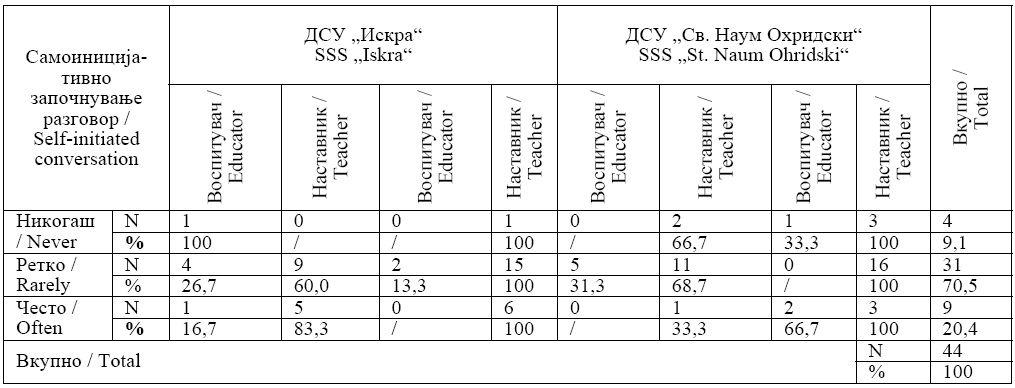
Fisher Exact test p= 0.063 p>0.05
|
Табелата покажува дека 70,5% од воспитно-образовниот кадар во двете училишта се изјасниле дека учениците кои манифестираат нарушено однесување ретко самоиницијативно го започнуваат разговорот, односно ретко бараат помош за проблемите со кои се соочуваат. Околу 20% одговориле дека учениците често бараат помош, а помалку од 10% дека учениците со растројства во однесувањето никогаш не започнуваат разговор, односно не бараат помош самоиницијативно. |
|
The table indicates that most of the educational staff in both schools (70.5%) responded that students who manifest behavioral disorders rarely voluntarily initiate a conversation and ask for help. About 20% said that students often ask for help and less than 10% stated that students with behavioral disorders never start conversation or ask for help voluntarily. |

|
Слика 1: Интересот на родителите за проблемите на учениците според воспитно-образовниот кадар |
|
Figure 1: Parents’ interest in the problems of the students in relation to the behavioral disorders according to the educational staff |
|
Според сликата 1, 86,4% од воспитно-образовниот кадар од двете училишта се изјасниле дека родителите на учениците кои имаат нарушено однесување ретко покажуваат интерес за проблемите на своите деца.
|
|
Based on Figure 1 it can be concluded that 86.4% of the educational staff from both schools suggests that the parents of the students with behavioral disorders rarely show interest in the problems of their children.
|
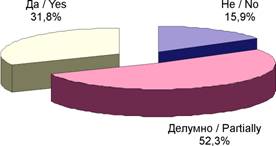
|
Слика 2:Корелација на училишниот успех и растројствата во однесувањето кај учениците со ЛИП според воспитно-образовниот кадар |
|
Figure 2:Correlation of school achievement and behavioral disorders in students with MID according to the educational staff |
|
|
|
|
|
Од сликата 2 се констатира дека 52,3% од воспитно-образовниот кадар во двете училишта сметаат дека постои делумна поврзаност помеѓу манифестирањето на неприфатливо однесување и училишниот успех на учениците. Речиси една третина - 31,8 % од воспитно-образовниот кадар сметаат дека училишниот успех е во корелација со појавата на растројства во однесувањето, а 15,9% сметаат дека проблематичното однесување не е условено од училишните постигнувања. |
|
Based on Figure 2 it can be concluded that 52.3% of the educational staff in both schools believe that there is a partial connection between the manifestation of unacceptable behavior and the school achievements of the students. Almost one third or 31.8% of the educational staff believes that school achievement is correlated with the emergence of deviant behavior, while 15.9% believe that the problematic behavior is not conditioned by the achievements in school.
|
|
|
|
|
|
Табела 4:Поведението на учениците со ЛИП во однос на нивниот училиштен успех |
|
Table 4: Behavior of students with MID in relation to their school achievements |
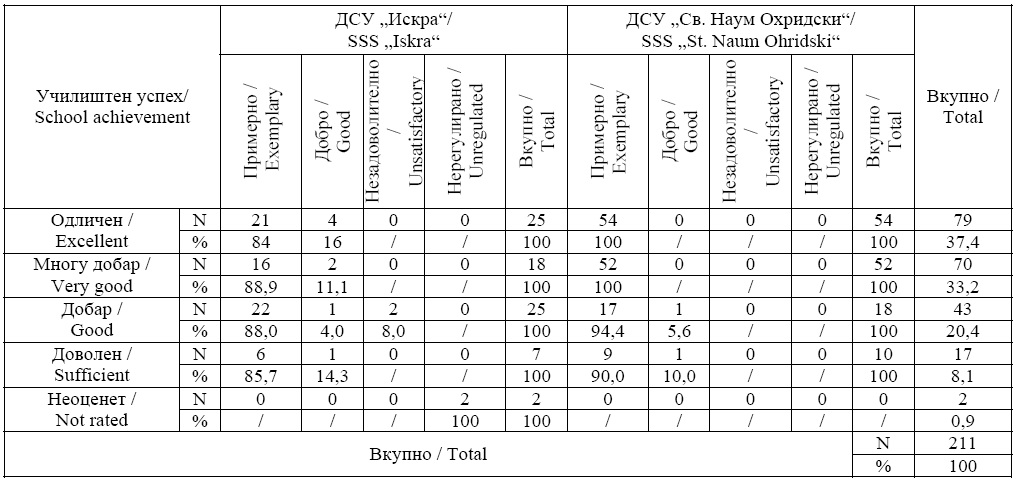
Fisher Exact test p < 0.001
|
|
||
|
Табела 5:Поведението на учениците со ЛИП според местото и начинот на згрижување |
|
Table 5: Behavior of the students with MID according to the place and manner of accommodation |
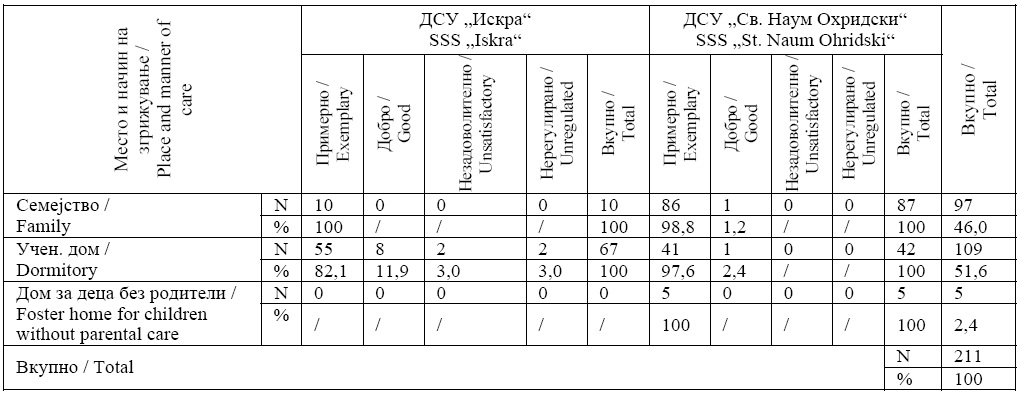
Fisher Exact test p<0.001
|
Со статистичка обработка на податоците добиен е резултат p=0.115, односно p>0.05, што значи дека не постои статистички значајна разлика во поведението на учениците со ЛИП, кои се од различен пол. Ова упатува на заклучокот дека полот не влијаe на појавата, односно манифестирањето на растројство во однесувањето кај учениците со ЛИП што не е случај кај учениците од редовните средни училишта. |
|
The statistical data processing delivered the result p = 0.115, respectively p> 0.05, which means that there is no statistically significant difference in the behavior of students with MID that are of the opposite gender. This leads to the conclusion that gender does not affect the emergence or manifestation of deviant behavior among students with MID which is not the case with students in regular high schools. |
||
|
Дискусија |
|
Discussion |
||
|
Според добиените резултати од истражувањето може да се констатира дека во 62,3% од вработените сметаат дека најчесто манифестиран облик на растројство во однесувањето кај учениците е деликвенцијата, а во најмал процент (под 5%) се застапени обидите за самоубиство, наркоманијата и хазардните игри. Во врска со информираноста на учениците за последиците од неприфатливото однесување, 56,8% од воспитно-образовниот кадар одговориле дека учениците се делумно информирани, додека 70,45% од вкупниот број вработени одговориле дека учениците ретко први започнуваат разговор или самоиницијативно бараат помош. Родителите на учениците во 86,4% според мислењето на воспитно-образовниот кадар ретко се заинтересирани за заемна соработка. Според мислењето на 52,3% од вработените во двете училишта, корелацијата меѓу растројствата во однесувањето и училишниот успех е делумно изразена, додека една третина од вкупниот број вработени сметаат дека постои таква корелација. Со статистичката обработка на податоците за поврзаноста меѓу училишниот успех и поведението (p<0.001), можеме да заклучиме дека постои силна заемна поврзаност меѓу овие два параметри. Во однос на застапеноста на воспитната компонента, добиен е резултат p<0.05, односно постои статистички значајна разлика во застапеноста на воспитната и образовната компонента во наставата. Добиените резултати покажуваат дека поголем дел од испитаниците (54,5%) сметаат дека интернатскиот начин на згрижување на учениците со ЛИП не влијае на појавата на растројствата во однесувањето кај истите, додека со статистичката обработка на податоците (p<0.001) се доаѓа до заклучокот дека начинот и местото на згрижување на учениците со ЛИП има големо влијае на појавата, односно манифестирањето на растројствата во однесувањето кај истите. Со анализа на податоците за влијанието на временскиот престој во ученички дом е добиен резултат p<0.005, што значи дека должината на престојот во ученички дом влијае на појавата на растројствата во однесувањето. Со статистичка обработка на податоците, добиен е резултат p=0.115, односно p>0.05, што значи дека не постои статистички значајна разлика во поведението на учениците со ЛИП кои се од различен пол. Ова упатува на заклучокот дека полот не влијаe на појавата, односно на манифестирањето растројства во однесувањето кај учениците со ЛИП. |
|
Based on the data obtained during the research, we came to the conclusion that 62.3% of the employees stated that the most represented manifested form of behavioral disorder among students is delinquency, and the suicide attempts, drug abuse and gambling are represented with the lowest percentage (under 5%). Regarding the awareness of students about the consequences of deviant behavior, 56.8% of the educational staff responded that students are partially informed, while 70.45% of the total number of employees responded that students rarely start conversation or ask for help voluntarily. According to the opinion of 86.4% of the educational staff, the parents of the students are rarely interested in mutual cooperation. 52.3% of the employed staff in both schools believes that a correlation between deviant behavior and school achievement is only partially expressed, while one-third of the total number of employees believes that such correlation exists. Based on the statistical data processing in relation to the connection between school achievement and the behavior (p < 0.001), we can conclude that there is a strong mutual relationship between these two parameters. With regard to the representation of the educational component, we obtained the result p < 0.05, which means that there is a statistically significant differences in the educational and pedagogical component in teaching. The obtained results show that the majority of respondents (54.5%) believe that accommo¬dation of students with MID in residential schools does not affect the emergence of deviant behavior among them, while the results obtained from the statistical data processing (p < 0.001) lead to the conclusion that the manner and place of accommodation of the students with MID has a great influence on the appearance or manifestation of deviant behavior. Analyzing the impact of the length of stay in student homes the result p < 0.005 has been obtained, which means that the length of stay in the student homes affect the emergence of deviant behavior. Using the statistical data processing the resultant p = 0.115, respectively p > 0.05 has been obtained, which means that there is no statistically significant difference in the behavior of students with MID of the opposite gender. This leads to the conclusion that gender does not affect the emergence or manifestation of deviant behavior among students with MID. |
||
|
Заклучок |
|
Conclusion |
||
|
Деликвенцијата претставува најсериозен проблем во однесувањето на учениците со интелектуална попреченост. На основа на резултатите во истражувањето добиени од воспитно-образовниот кадар во двете училишта, може да заклучиме дека учениците не се подеднакво информирани за можните последици од различните форми на растројства во однесувањето. Имено, и самите податоци во табелата 2 укажуваат дека учениците во „Искра“ од Штип, според воспитно-образовниот кадар, располагаат со повеќе информации за појавата и последиците на растројствата во однесувањето. Овој заклучок упатува на потребата од дополнителна групна и индивидуална работа на стручниот тим со учениците кои се со социјален ризик, како и со учениците чие однесување отстапува од стандардното и вообичаено однесување. Исто така, овој заклучок налага медиумите да овозможат поголем простор во своите програми за емисиите од воспитно-образовен карактер и доследно да се придржуваат на правните прописи кои се однесуваат на термините кога се прикажува програма чија содржина има насилство и социјално-патолошки појави. Овој заклучок упатува на потребата од зголемена активност на невладиниот сектор и локалната самоуправа во органи-зирањето на слободното време на овие лица и нивно вклучување во разни културно-забавни, спортско-рекретивни и други активности кои ќе овозможат правилен развој на лицата со интелектуална попреченост. Учениците со ЛИП кои имаат подобри училишни постигања во значителна мера манифестираат повеќе просоцијални, отколку неприфатливи форми на однесување, што укажува дека таквите ученици имаат развиено позитивни морални и општествени ставови, како и поголемо чувство на одговорност, за разлика од нивните врсници кои имаат незадоволителен или послаб училиштен успех. На овој заклучок упатуваат и официјалните податоци од Државниот завод за статистика на Бугарија, според кои, од вкупниот број малолетници на кои им е изречена воспитна мерка, во 2006 и 2007 година во просек 5,7% биле неписмени, 8,2% со неоформено основно образование, 31% со осумгодишно основно образование, 49% биле со четиригодишно основно училиште, а само 6,2% имале средно образование. Овој заклучок ја наметнува потребата од организирање на дополнителна индивидуална воспитно-образовна работа со цел развивање на чувството за одговорност и морални вредности заради поуспешна и поефикасна социјална интеграција на овие ученици. Подолгиот престој во ученичките домови негативно се рефлектира на однесувањето на учениците со интелектуална попреченост, односно со зголемување на времетраењето на престојот во домовите се зголемува и обемот на манифестираните растројства во однесувањето. Сето ова укажува дека здравото семејството е најоптимална средина во која се задоволуваат основните биолошки, емоционални и социјални потреби и како такво претставува добра основа за формирање позитивни морални ставови и манифестирање прифатливи форми на однесување. Добиените податоци укажуваат дека полот кај учениците со интелектуална попреченост нема значајно влијание на однесувањето, што значи неприфатливите форми на однесување подеднакво се јавуваат кај двата пола, што не е случај кај учениците од редовните средни училишта. Учеството на малолетничките од понежниот пол во вкупниот малолетнички криминалитет во Македонија во периодот од 1998 до 2007 се движи од 2 до 4 %, и тој сооднос изнесува околу 34:1 во корист на малолетниците од машкиот пол. Во Бугарија во периодот од 2000 до 2007 соодносот во учеството во криминалитетот и според полот изнесува 18:1 во корист на малолетниците од машкиот пол. Во Србија во периодот од 2002 до 2006 во фазата на осудени тој сооднос на учеството во криминалитетот изнесува 21,3:1 во корист на малолетниците од машкиот пол. Соодносот, пак, на учество во манифестирањето на асоцијалните однесувања според полот во Македонија изнесува 7,8:1 во корист на машкиот пол. Во Бугарија тој сооднос изнесува 2,8:1 во корист на малолетниците од машкиот пол (15). Евидентната разликата во застапеноста на децата и младите од понежниот пол во манифестирањето на различните облици на асоцијално и антисоцијално однесување, главно се должи на обичаите, традицијата и културата во македонското семејство, а посебно во улогата на девојчињата во семејството за време на развојниот период. |
|
Delinquency is the most serious problem in the behavior of students with intellectual disability. Based on the results obtained within the research from the educational staff in both schools, we can conclude that the students are not equally informed about the possible consequences of the various forms of behavioral disorders. Namely, the data in Table 2 indicate that students in "Iskra" Shtip, according to the educational staff, have more information on the occurrence and consequences of behavioral disorders. This conclusion points to the need for additional group and individual work of the expert team with the students who are in social risk, as well as with the students whose behavior deviates from the standard and usual behavior. This conclusion also requires the media to provide more space in their programs for programs of the educational character and to meet the legal regulations concerning the hours for broadcasting pro-grams whose contents have violence and social and pathological appearances. This conclusion points to the need for increased activity of NGOs and the local self-government in organizing the free time for these people and their involvement in various cultural, entertainment, sport and other recreational activities and other activities which will provide for proper development of the people with intellectual disabilities. Students with MID who realized better school achievements, manifest significantly more pro-social than unacceptable forms of behavior, which suggests that such students have developed positive moral attitudes, as well as a greater sense of responsibility, compared to their peers who have unsatisfactory or poor school achievements. The official data of the State Statistical Office of Bulgaria also points to this conclusion and according to them 5.7% of the minors, upon which in 2006 and 2007 a corrective measure has been imposed, are illiterate, 8.2% haven’t completed the primary education, 31% have completed 8 years of primary education, 49% have completed 4 years of primary education, and only 6.2% have completed secondary education. This conclusion highlights the need for organizing additional individual educational activities in order to develop the sense of responsibility and moral values for the purpose of more successful and more efficient socialization of these students. The longer duration of stay in student homes has a negative effect on students with intellectual disability, namely by increasing the duration of stay in student homes, there is an increase in the volume of the manifested behavioral disorders. All these suggest that a healthy family is the most optimal environment in which the basic biological, emotional and social needs can be satisfied and it represents a good basis for development of positive moral attitudes and manifestation of acceptable forms of behavior. The obtained results indicate the sex among students with intellectual disability has no significant impact on the behavior, which means that unacceptable forms of behavior occur equally in both sexes, which is not the case with the students who go to regular secondary schools. The participation of female juveniles in the overall juvenile crime in Macedonia in the period from 1998 to 2007 is between 2% and 4% and this proportion is 34:1 in favor of the male juveniles. In Bulgaria, in the period between 2000 and 2007, the proportion of participation in crime according to sex is 18:1 in favor of the male juveniles. In Serbia, in the period from 2002 to 2006, in the stage of convictions, this proportion of participation in crime is 21.3:1 in favor of the male juveniles. The proportion of participation in the manifestation of antisocial behavior according to sex in Macedonia amounts 7.8:1 in favor of the males. In Bulgaria this proportion is 2.8:1 in favor of male juveniles (15). The evident difference in the participation of female children and youngsters in the manifestation of different shapes of unsocial and antisocial behavior is mainly due to the customs, tradition and culture of the Macedonian family, and especially to the role of girls in the family during the period of development. |
||
|
Конфликт на интереси |
|
Conflicts of interests |
||
|
Авторите изјавуваат дека немаат конфликт на интереси. |
|
Authors declare no conflict of interest. |
||
|
Citation: Kitkanj Z, Georgieva E. Behavioral Disorders in Adolescents with Mild Intellectual Disability. J Spec Educ Rehab 2013; 14(3-4):7-21. doi: 10.2478/jser-2013-000810.2478 |
||||
|
Article Level Metrics |
||||
|
|
|
|
||
|
|
|
||
Share Us
Journal metrics
-
 SNIP 0.059
SNIP 0.059 -
 IPP 0.07
IPP 0.07 -
 SJR 0.13
SJR 0.13 -
 h5-index 7
h5-index 7 -
 Google-based impact factor: 0.68
Google-based impact factor: 0.68
10 Most Read Articles
- PARENTAL ACCEPTANCE / REJECTION AND EMOTIONAL INTELLIGENCE AMONG ADOLESCENTS WITH AND WITHOUT DELINQUENT BEHAVIOR
- RELATIONSHIP BETWEEN LIFE BUILDING SKILLS AND SOCIAL ADJUSTMENT OF STUDENTS WITH HEARING IMPAIRMENT: IMPLICATIONS FOR COUNSELING
- EXPERIENCES FROM THE EDUCATIONAL SYSTEM – NARRATIVES OF PARENTS WITH CHILDREN WITH DISABILITIES IN CROATIA
- INOVATIONS IN THERAPY OF AUTISM
- AUTISM AND TUBEROUS SCLEROSIS
- THE DURATION AND PHASES OF QUALITATIVE RESEARCH
- REHABILITATION OF PERSONS WITH CEREBRAL PALSY
- DISORDERED ATTENTION AS NEUROPSYCHOLOGICAL COGNITIVE DISFUNCTION
- HYPERACTIVE CHILD`S DISTURBED ATTENTION AS THE MOST COMMON CAUSE FOR LIGHT FORMS OF MENTAL DEFICIENCY
- DIAGNOSTIC AND TREATMENT OPTIONS IN AUTISTIC SPECTRUM DISORDERS – AN OVERVIEW

